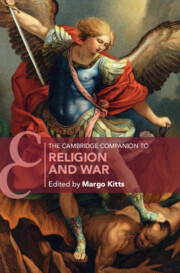Book contents
- The Cambridge Companion to Religion and War
- Cambridge Companions to Religion
- The Cambridge Companion to Religion and War
- Copyright page
- Contents
- Contributors
- Preface
- Introduction
- Part I Classical Foundations
- 1 Biblical Paradigms of War in History and Eschatology
- 2 Early Christianity and War
- 3 Fighting and Martial Valor in Islamic Thought
- 4 Hinduism and War
- 5 Buddha in the Ring of Fire
- 6 Sikhism
- 7 Religion and War in Traditional China
- 8 Buddhism and War in Premodern Japan
- Part II Just War
- Part III Religious Nationalism
- Part IV Featured Conflicts
- Index
- Cambridge Companions to Religion (continued from page ii)
- References
7 - Religion and War in Traditional China
from Part I - Classical Foundations
Published online by Cambridge University Press: 04 May 2023
- The Cambridge Companion to Religion and War
- Cambridge Companions to Religion
- The Cambridge Companion to Religion and War
- Copyright page
- Contents
- Contributors
- Preface
- Introduction
- Part I Classical Foundations
- 1 Biblical Paradigms of War in History and Eschatology
- 2 Early Christianity and War
- 3 Fighting and Martial Valor in Islamic Thought
- 4 Hinduism and War
- 5 Buddha in the Ring of Fire
- 6 Sikhism
- 7 Religion and War in Traditional China
- 8 Buddhism and War in Premodern Japan
- Part II Just War
- Part III Religious Nationalism
- Part IV Featured Conflicts
- Index
- Cambridge Companions to Religion (continued from page ii)
- References
Summary
All aspects of war in China were surrounded by religious activities, ranging from rituals to predict the future and guarantee success in war and the safety of its participants to rituals dealing with the bloody aftermath of war.
- Type
- Chapter
- Information
- The Cambridge Companion to Religion and War , pp. 164 - 186Publisher: Cambridge University PressPrint publication year: 2023

